100th Anniversary Great Nave Tour at the Cathedral of St. John the Divine
Celebrate the 1925 construction of the stunning nave inside the world's largest Gothic cathedral!


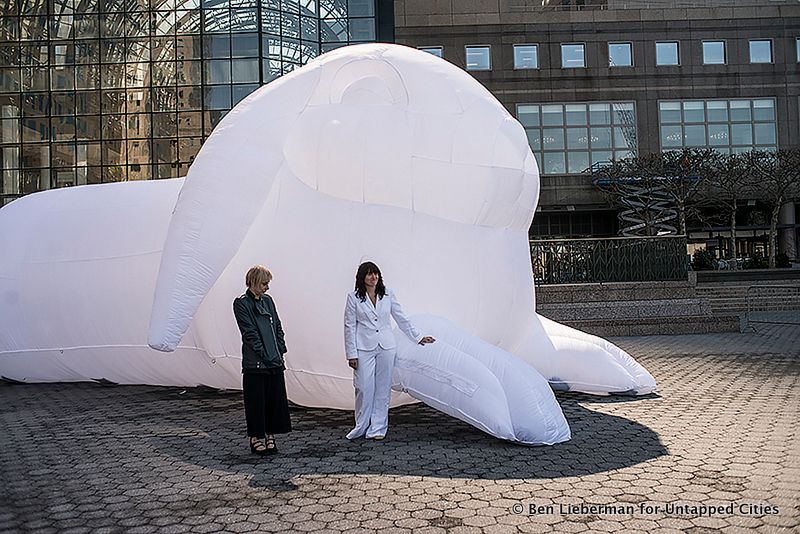
In the month of April, New York City’s exhibits and installations brings to the forefront pieces that ponder the state of our environment, and what we are leaving behind for those who will follow. One work lends an artistic eye towards leaving earth, with a fantastical view of our planet; another explores the meaning of self from the banners we fly, to the photos we hold dear. On the heels of Women’s History Month, you can continue to explore women in the arts. There will be art in many forms, from an upright swimming pool to a mosh pit. Spring also brings us back into our parks, in the form of an art exhibit at The Arsenal, a fort landscape exhibit at the Dana Discovery Center, and a DNA Totem Pole at the Marcus Garvey Park in Harlem. In your travels from exhibits to installations, remember to look both ways – so you won’t get hit by a giant bunny!
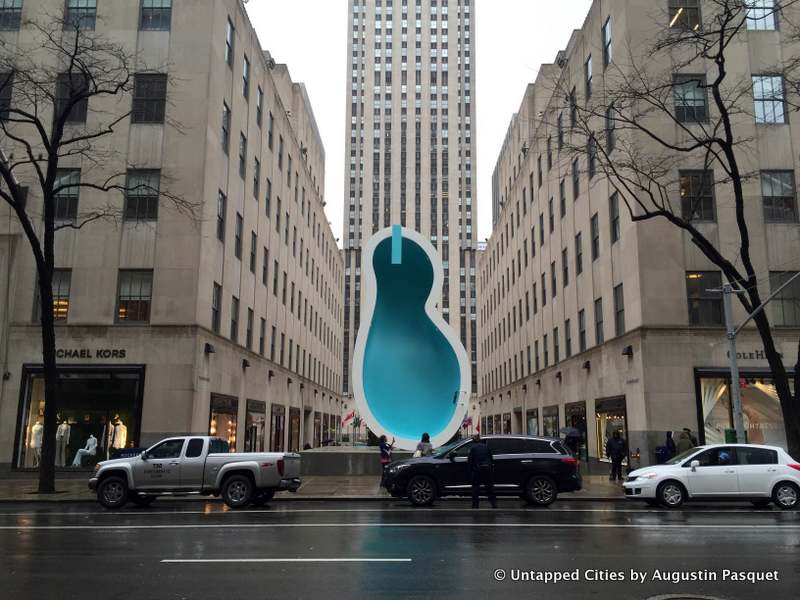
Artists Elmgreen and Dragnet will be installing a sideways swimming pool, entitled Van Gogh’s Ear at Rockefeller Center starting April 13. The sculpture, organized by the Public Art Fund,, plays at the urban dream, particularly of New Yorkers, for beautiful public swimming pools in dense, built up areas (+POOL is a possible reality, to be in the East River, the dumpster pools on Park Avenue a fleeting appearance for Summer Streets). The sculpture will have a cyan blue interior, diving board, swimming pool lights, and a polished stainless steel ladder.
As the Public Art Fund Press release states, “Conceived specifically for this site, where fashion, commerce, tourism, business, and art collide, the work playfully contradicts our expectations of both this familiar object and iconic site.” It also gives 30 Rock a cheeky run for its money, partially blocking the view of the skyscraper popular with tourists. Van Gogh’s Ear will be on view from April 13 to June 3, at Fifth Avenue and 50th Street, in the Channel Gardens at Rockefeller Center.

In celebration of the one year anniversary of the reopening of Brookfield Place New York, ArtsBrookfield commissioned two giant rabbits, each scaling over two-stories in height, to join Intrude’s five original sculptures, which were prominent pieces of work during the 2014 Festival in Sydney. Artist Amanda Parer views the rabbit as an animal of contradiction, since she comes from Australia, a country where rabbits have caused a great imbalance to the country’s natural ecosystem since first introduced by white settlers in 1788.
While there is visual humor in the large rabbits, she hopes to reveal a more serious environmental message – the natural world in all its fragility. The inflatable installations are made from nylon and have a zipper at the side of the form, with an LED light placed inside. Hop on over and view Intrude from April 17 to April 30 at Brookfield Place, 230 Vesey Street.
The High Line Wall at 22nd Street is sporting a new mural, replacing artist Kerry James Marshall’s images of New York City’s water towers as luxury condos and apartments. In a criticism of culture and power, Blind Idealism Is…..Deadly by artist Barbara Kruger is an adaptation of a quote from Afro-Caribbean philosopher and revolutionary thinker, Franz Fanon – recreated by Kruger as a hand-painted mural. The mural, which went up on March 21st, will be on view through March, 2017.
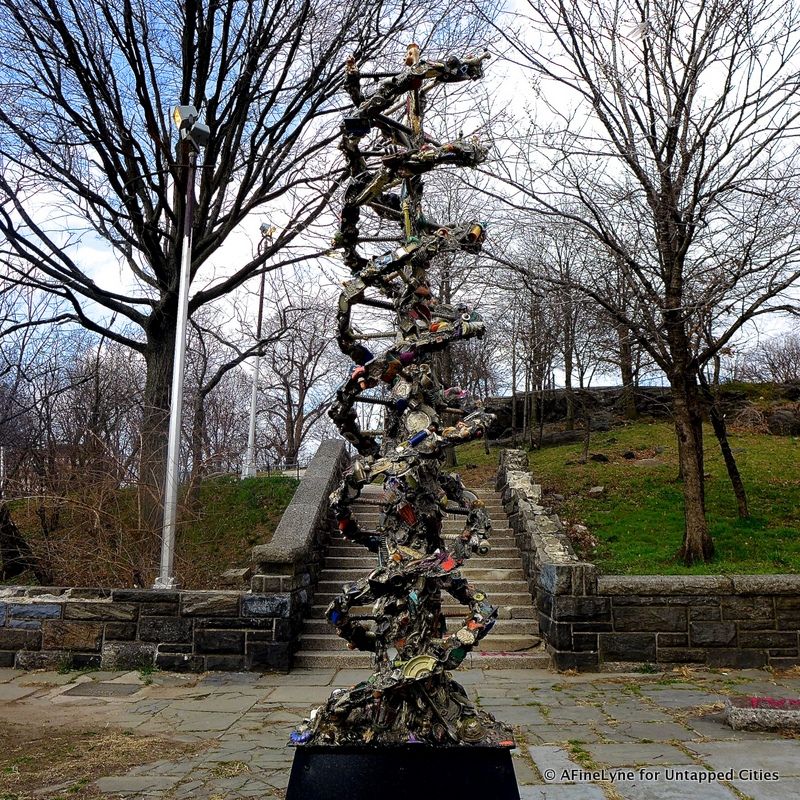
The DNA Totem located at the 120th Street and Fifth Avenue in Marcus Garvey Park
Marcus Garvey Park has become another destination for sculpture artists within the New York City Parks Department. The DNA Totem, by local sculptor artist Suprina Kenney opens a discussion on the subject of human evolution and the footprint humans leave behind. The ten-foot tall spiral form, which makes up the DNA Totem, is fixed with discarded items donated by local residents, and found objects from the artist. Bringing to the viewer’s attention unwanted objects that show how we are “beautiful, horrid, tragic and profoundly funny” in our sampling of objects, it also represents the 102 tons of trash we each create in our lifetime.
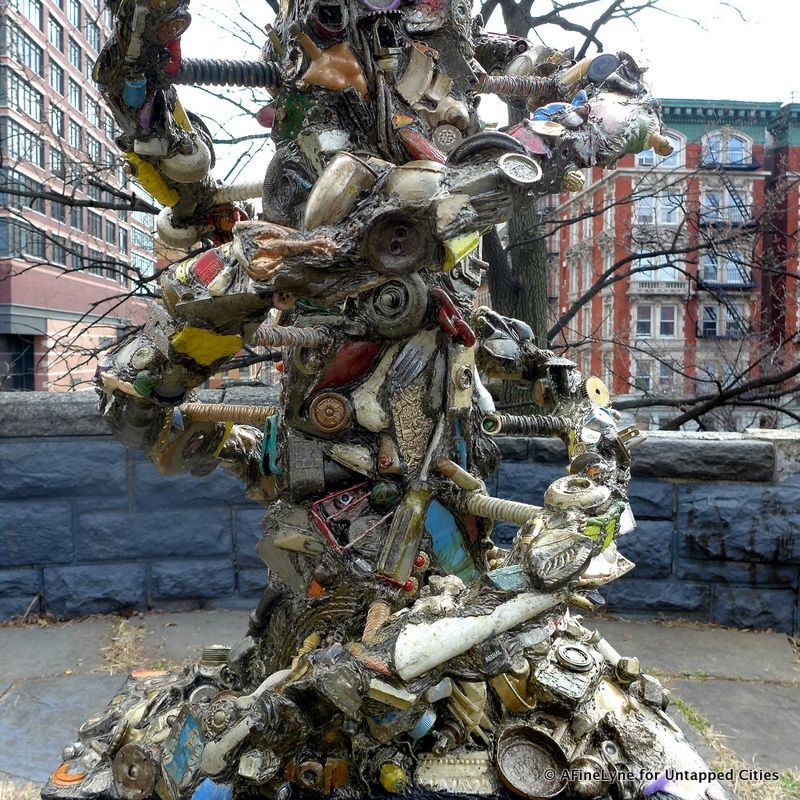
A close-up of the DNA Totem, overlooking Fifth Avenue
Spearheaded by the Marcus Garvey Park Alliance, in conjunction with the New York City Parks Department, The DNA Totem sits on the first level of the Acropolis, overlooking Fifth Avenue on 120th Street, a few levels below the sight of the historic Harlem Fire Watchtower, which is currently being restored, and a half block away from the Maya Angelou townhouse. The DNA Totem will be on view through September 30.
An opening reception will take place on April 9 from 4:30-6 pm, with the reception beginning at the DNA Totem, and continuing across the street at Heath Gallery, where Suprina will have other pieces on display. A series of related talks and activities are also scheduled.
The current installation, Caesura: a forum, which is located at the top of the Acropolis in Marcus Garvey Park, will be coming down in mid-April.
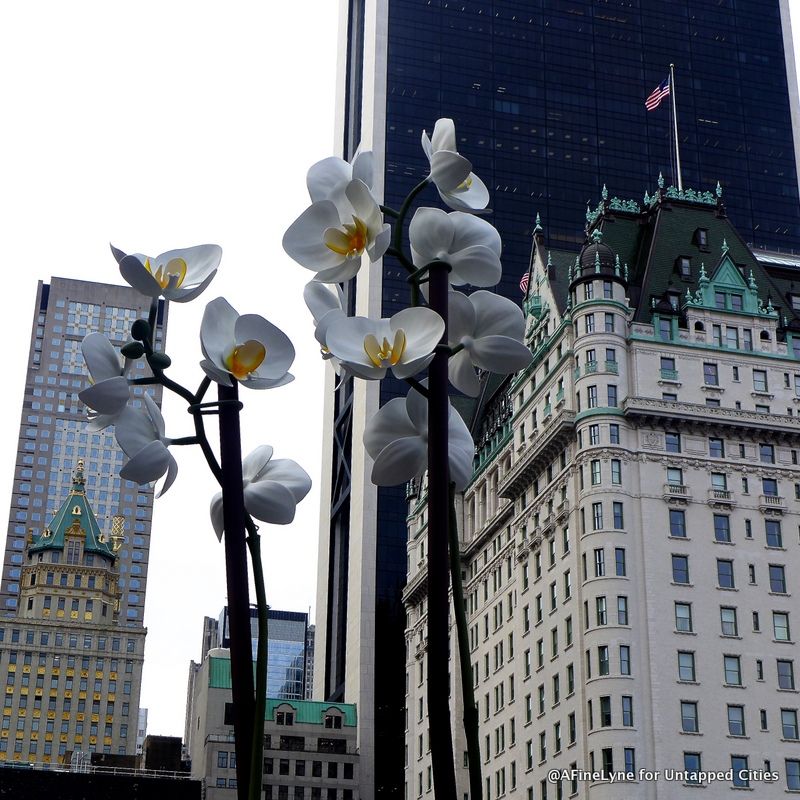
The Public Art Fund’s installation at the the Doris Freedman Plaza is an ode to Spring. Two Orchids by the German artist Isa Gengken, which was a subject of a retrospective at The Museum of Modern Art in 2013, features two enormous orchid flowers, standing twenty-eight feet and thirty-four feet tall on the Plaza at Fifth Avenue and 60th Street. The Public Art Fund describes this piece as an “idealized, colossal version of the familiar plant: a civic monument to the perfect orchid, now the chosen ornament of contemporary culture…the mass-produced, white orchid, has become the quintessential flower of our age: global, accessible, and open to interpretation.” Two Orchids will be on view through August 21 at the Doris C. Freedman Plaza, Fifth Avenue at 60th Street.
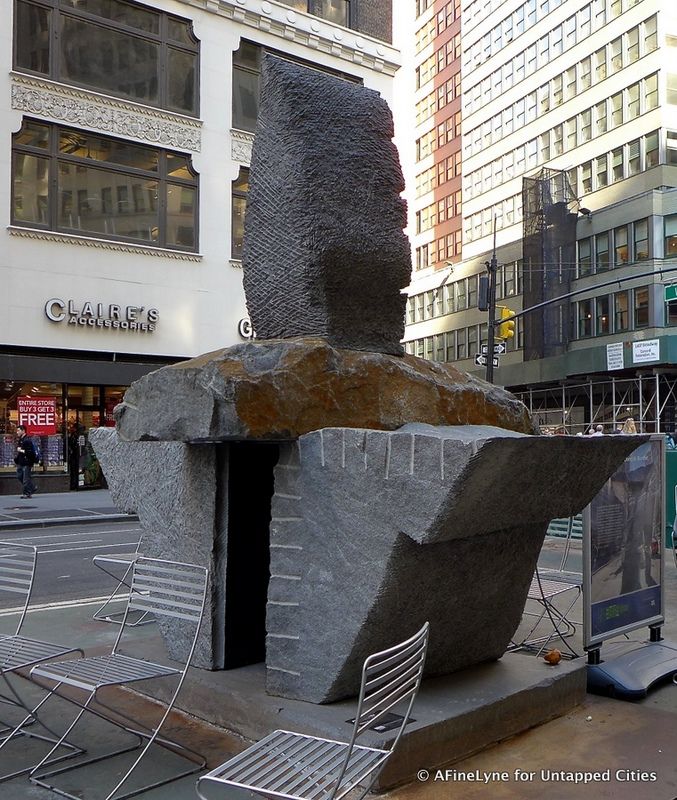
Sculpture entitled ‘Enki’, located on Broadway between 36th and 37th Streets
The Garment District Alliance continues on its creative track of choosing art that blends in with our urban environment. In conjunction with Arterventions (part of the New York City Department of Transportation’s Art Program) the current installation, Mass Medium was created by renowned sculpture artist Harry H. Gordon. His five works collectively weigh 102,000 pounds and were created from fine Pennsylvania black granite. His choice of medium, granite, was a good choice, since Manhattan is largely a protrusion of this rock, rising a few hundred feet from sea-level. Beginning at 41st Street, moving south to 36th Street on Broadway, Mass Medium is made up of five sculptures that will be on view through April 15.
Hey! Ho! Let’s Go: Ramones and the Birth of Punk is a celebration of the 40th anniversary of the first album of the Ramones in 1976. The Queens Museum and the Grammy Museum have partnered in a two-part exhibition, each part exploring the group ‘s lasting influence through a different lens. The Queens Museum will take viewers through the Ramones’ roots in Queens, their music, fashion, fine art, comics and film. The Grammy Museum will present a broader picture of the band as a pantheon of music and pop culture.
On display will be a colorful wall of concert posters spanning five continents and three decades, and more than 150 snapshots, fliers, posters, t-shirts, tour itineraries and memorabilia on loan from the Ramones’ longtime tour manager, Monte A. Melnick. Hey! Ho! Let’s Go: Ramones and the Birth of Punk will be on view from April 10 through July 31, 2016 at the Queens Museum, Flushing Meadows Corona Park in Queens. Opening Reception April 10 from 4-8 pm.
While you’re at the Queens Museum, check out Nonstop Metropolis: The Remix. Here you will find writer, historian and activist, Rebecca Solnit giving viewers a peek into her trilogy of Atlas books, proposing creative mapping as a means to relay alternative histories of place. This year, the third and final book in the series will have New York City as its subject. Nonstop Metropolis: The Remix will be on view from April 10 through January 1, 2017.
Garden City/Mega City at the Skyscraper Museum features the work of WOHA, the Singapore architects Wong Mun Summa and Richard Hasseil. They are well-known for designing tropical towers enveloped by nature, and for creating vertical villages with sky gardens, breezeways, and elevated parks. This exhibit focuses on twelve projects that illustrate the firm’s philosophy and strategies in vertical density.
The projects are represented in models, renderings, photographs and film. The exhibition also previews WOHA’s upcoming volume Garden City/Mega City: Rethinking Cities in the Age of Global Warming, to be published by Pesaro Publishing in May, 2016. The exhibit will be on view through September 4, 2016 at The Skyscraper Museum in Battery Park City, located at 39 Battery Place.
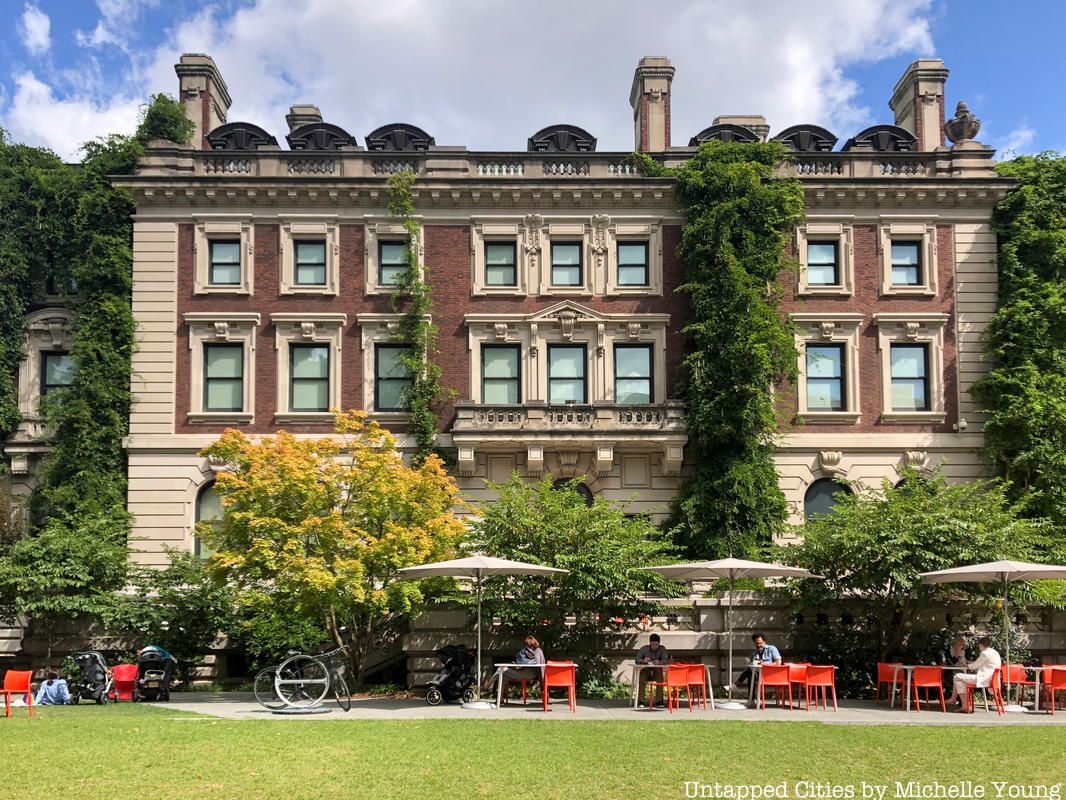
Using historic and contemporary mirrors and frames from Cooper Hewitt’s collection, renowned fashion designer Thom Browne explores ideas of reflection and individuality in the exhibit Thom Browne Selects. The exhibit is not without his own personal touch, using fifty-six pairs of his reflective silver-plated shoes, his desk, chair, typewriter and coat stand. In this exhibit, Mr. Brown re-examine’s codes of conventional fashion, and celebrates the notion of the individual, playing on the idea of reflection. Thom Browne Selects is part of Cooper Hewitt, Smithsonian Design Museum’s popular “Selects” series. The exhibit will be on view through October 23 at Cooper Hewitt, 2 East 91st Street.
While you’re at Cooper Hewitt, check out the Models and Prototypes Gallery on the second floor. This is the new home to rotating installations showcasing the important role of design models and prototypes. Currently on view are 18th and 19th century models of staircases. Most of the staircase models produced in the tradition known as compagnonnage were made by masters of woodworking, such as joiners, cabinet makers and carpenters.
A Democracy of Imagery is an exhibition of work by 84 photographers from the 1860s through 2002. Curated by Colin Westerbeck, the exhibit presents 100 images by artists including Richard Avedon, Edward Burtynsky, Henri Cartier-Bresson, Walker Evans, Robert Frank, Saul Leiter, Vivian Maier, Man Ray, Robert Mapplethorpe, Joel Meyerowitz and Gordon Parks. The photographs include Saul Leiter’s photograph of a young Andy Warhol, showing the artist reviewing images when he was known as an illustrator; Allen Ginsberg’s 1989 photograph of David Hockney and William S. Burroughs as two well-dressed gentlemen; and Alfred Hitchcock hamming it up for the camera in a 1942 photograph by Goon Mili. A book entitled A Democracy of Imagery will be published later this year (but available for pre-order on Amazon) by Steid/Howard Greenberg Library, 2016.
The exhibit, A Democracy of Imagery is on view through April 30 at the Howard Greenberg Gallery, 41 East 57th Street, 1406.
Michael Najjar is one of the pioneer astronauts of Richard Branson’s Virgin Galactic. He’s been undergoing an intensive training in Star City, Russia since 2012, and is actually scheduled to board SpaceShipTwo in the near future. Michael Najjar: Outer Space is a series of his large-scale photographs, inspired by cutting-edge aeronautic technologies and the space tourism industry. His fictitious realities capture an intense and futuristic world that examine vital connections between humans and technology, reality and simulation.
This is the German artist’s first solo exhibition with the gallery, and first major showing of his series in New York. He hopes to engage conversation and reflection on our world, what it means to us, and the generations that will follow. In addition to the exhibit, video artworks based on Najjar’s extreme training will be shown. Michael Najjar: Outer Space will be on view from March 31 through May 14, 2016 at Benrubi Gallery, 521 West 26th Street, #2.
Celebrating its 36th edition, The Association of International Photography Art Dealers (AIPAD), present The Photography Show. Eighty-six of the world’s leading fine art photography galleries will participate, exhibiting a wide range of work including documentation and photojournalism. Public programs will include panel discussions featuring leading curators, artists, dealers and journalists. The photography Show will have an opening night preview on April 13, and open to the public from April 14-17. The exhibit will be located at The Park Avenue Armory at 67th Street.
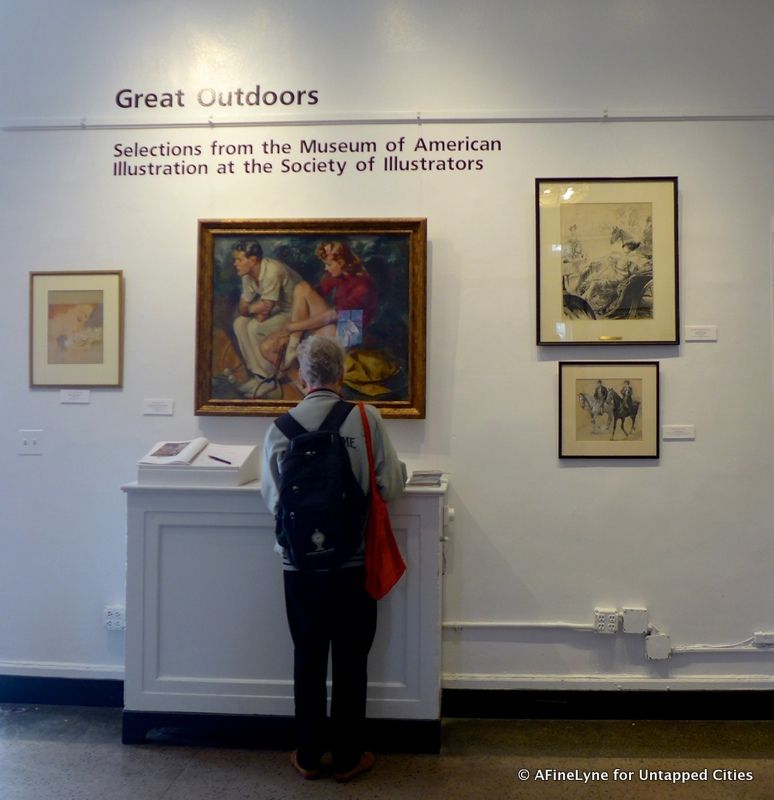
Great Outdoors showcases over thirty artworks from the Museum of American Illustrator’s collection. The Arsenal, located within Central Park, is a perfect location to showcase the depictions of outdoor life, recreational sports, ice skating, biking and other paintings of recreational life. The show features illustrations originally published in books, magazines and weeklies from Golden Age of Illustration (1880-1920) through 2014. The exhibit is on view through April 21 at New York City Park’s Arsenal Gallery, located at Fifth Avenue and 65th Street.
The Studio Museum in Harlem explores the domain of home, as the viewer examines the intersection of race, class, gender and socioeconomic policy in Rodney McMillan’s exhibit Views of Main Street. Bringing together twenty pieces, from painting and sculpture to video and performance, Mr. McMillian uses basic symbols of domesticity to scrutinize the myth of a universal, middle-class “Main Street.” Highlighting economic distress, home foreclosures, and unemployment, he hopes to bring about discussion, and he challenges the terms that government and the media use to discuss justice, democracy and rights of citizens in the private space. Views of Main Street is one of seven exhibits opening on March 24 through June 26. The Studio Museum in Harlem is located at 144 West 125th Street.
The final wave of Agitprop! will open on April 6th, with the addition of fifteen contemporary artists and collectives, including works by Pussy Riot. Presented by the Brooklyn Museum’s Elizabeth A. Sackler Center for Feminist Art, the third and final installation of Agitprop! explores the legacy and continued power of politically engaged art including photography, film, banners, street actions, songs, social media, TV shows, and performances. Agitprop! The Final Wave will be on view through August 7 at the Brooklyn Museum, 200 Eastern Parkway.
The Affordable Art Fair will usher in seventy galleries, which will be exhibiting more than five-hundred artists. The artwork will range in price from $100 to $10,000 with more than half of the work priced under $5,000. In addition, there will be talks and tours, including a tour of the show by Susan Mumford, Founder of The Association of Women Art Dealers (AWAD), and a talk by Fair Manager, Vanessa Deis, about discovering the emerging women artists of the Affordable Art Fair NYC Spring Edition. The Affordable Art Fair will have a private viewing on March 30, and open to the public from March 31 through April 3. The show is located at The Metropolitan Pavilion, 125 West 18th Street, between 6th and 7th Avenues.
In 2013, a reconstruction project on a six-acre portion of Central Park‘s northern end revealed new archeological discoveries. Remnants of a fortification system built to protect the city during the War of 1812 and the surface of the Kingsbridge Road were uncovered. This new information gives us new insight into the pre-urban landscape from the entrance at Fifth Avenue and 106th Street, and a step ascending path which leads to a series of rocky bluffs overlooking the Harlem Meer. The exhibit Landforms: A History of Central Park’s Fort Landscape showcases the archaeological and historical findings and will open on April 15 at the Charles A. Dana Discovery Center located on 110th Street between Central Park West and Fifth Avenue. Hours are from 10 am to 5 pm.
In his first solo exhibit Mosh Pits, Human and Otherwise, artist Dan Witz features large-scale oil paintings on canvas produced over the past ten years. The now Brooklyn-based artist was originally inspired by subway graffiti while he was an art student. This exhibit reflects his background as a musician during the downtown scene in New York in the early 1980s, as well as the influence of Renaissance painters on his work. As the press release describes, Witz’ “large-scale oil paintings of rampant crowds embody a rebellious and provocative nature that’s heightened by a stunning hyperreal aesthetic.”
Mr. Witz photographs his subjects, prints an a-chromatic underpainting on canvas, and then glazes and scumbles over this foundation. Mosh Pits, Human and Otherwise will be on view through April 30 at the Jonathan LeVine Gallery, 529 West 20th Street, Gallery II.
Next, see more art installations to check out in NYC. Get in touch with the author at AFineLyne.
Subscribe to our newsletter